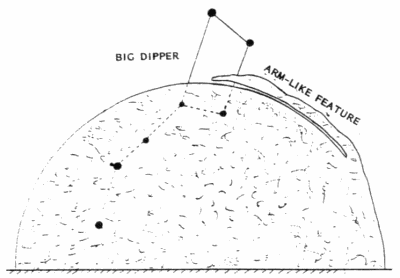 |
Science Frontiers ONLINE No. 137: SEP-OCT 2001 |
|
|
An Expanding Semicircle Of Light In The Night Sky
At dawn on 1 September 1986, I was preparing to terminate my astronomical observations when suddenly at 0200 UT in the north-north-east a small [luminous 1 'bubble' -- convex side upward appeared in the sky as viewed between two nearby buildings and the farther trees. The bubble ascended slowly, higher and higher, and developed into a huge semicircular cupola or dome before halting for a few minutes. Its homogeneous, uniform structure was striking as it shone with a strong, silvery-bluish light in the absolutely black sky. By then, the cupola almost completely covered the Big Dipper (Ursa Major) whose five or six brighter stars clearly sent their rays through the phenomenon. The cupola had sharply-cut edges all round it, until later when a thin arm-like feature separated from its right topside and bent in the direction of the cupola, while remaining slightly apart from it.
The semicircle (cupola) of light soon began to shrink and fade. By 02.23 UT it had disappeared. Rosa-Kiss suggested that the phenomenon may have been a precursor earthquake light associated with the Vrancea earthquake of August 31. 1986. that occurred in the Carpathians.
(Rosa-Kiss, Attila; "Earthquake Lights, or Celestial Medusa," Journal of Meteorology, U.K., 26:132, 2001.)
References. Earthquake lights (GLD8) and expanding balls of light on the horizon (GLA15), both in Lightning, Auroras, Nocturnal Lights...)
 August 28, 1986, Salonta, Romania. A semicircle of silvery light expanded above the north-northeastern horizon. |
Other Sites of Interest
|